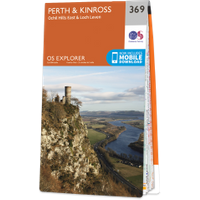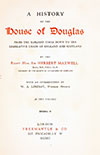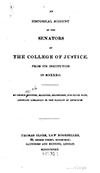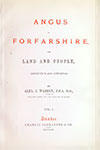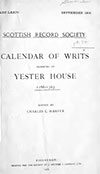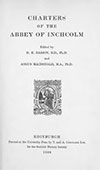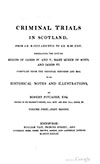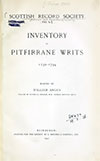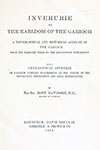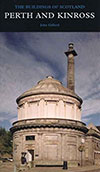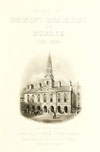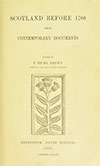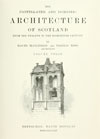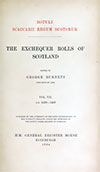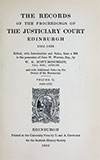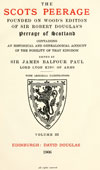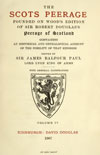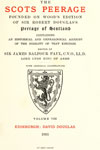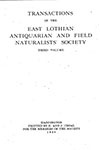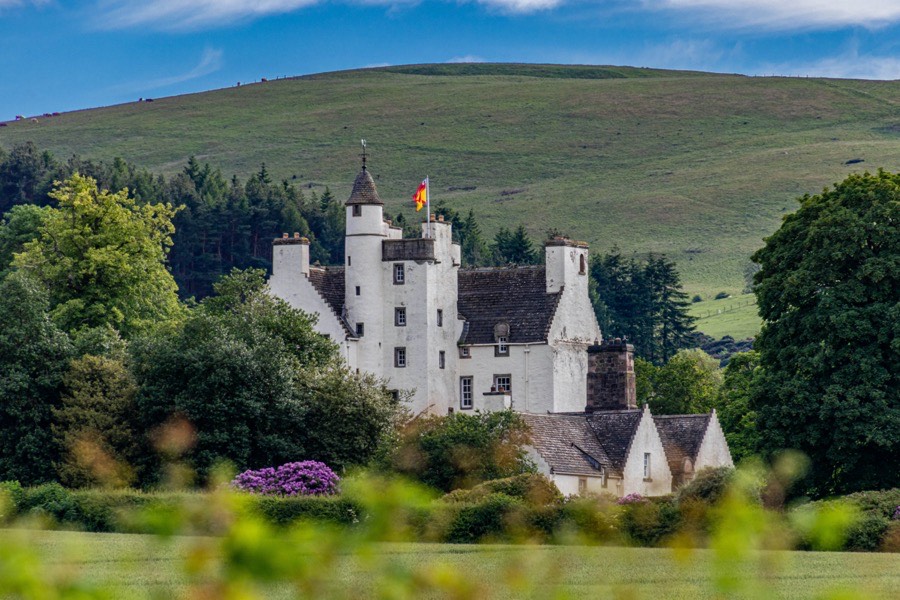

Balmanno Castle is a 16th century tower house which was remodelled and restored in the early 20th century by the architect Sir Robert Lorimer and is considered some of his best work.
The early history of Balmanno is not well-documented however it has been identified as a medieval moated site, the moat presumably filled by the nearby Dron Burn. Within the area encircled by the moat was a slight eminence on which would probably have been a timber building, later replaced by a stone structure. The site is overlooked by hills to the south however there are extensive views along the Firth of Tay and Carse of Gowrie as far as Dundee on a clear day.
The name derives from the Gaelic “baile manach”, meaning “monks’ farm”, perhaps suggesting an early ecclesiastical land holding. In 1420 David de Stirling, canon of Dunblane, was given the canonry and prebend of Balmanach in the collegiate church of Abernethy. There are other Balmanno-derived placenames in Ayrshire, Dunbartonshire, Fife, Inverness-shire, Kincardineshire, Stirlingshire and Wigtownshire however the Perthshire one was the seat of the family of Balmanno of Balmanno. A Hugh of Balmanno is recorded performing fealty to Edward I of England at Berwick-upon-Tweed in 1296.
Members of the Balmanno family occupied positions of some note in the 14th and 15th centuries. In 1361 Robert de Balmanauch was a bailie of Crail, Sir Thomas de Balmanach witnessed a document in St Andrews in 1387 and John de Balmanach was a bailie of Crail in 1405. Their stock seemed to rise as in 1434 Robert de Balmanach was clerk of the Privy Seal and three years later is recorded as making payments to the master of works at Stirling Castle.
In 1439 George de Balmanach was granted the lands of Fillederuchrye in the barony of Methven. Robert de Balmanach rendered the accounts of the bailies of Dundee in 1448 and the following year was Provost of Dundee. That same year a Robert de Balmanoch witnessed a charter by Alexander Lindsay, 4th Earl of Crawford, to his cousin, John of Hamilton, when he was described as secretary to the Earl.
Robert de Balmanoch de Dundee witnessed a charter to Alexander Cramond of Cramond in 1450 and between 1460 and 1482 served as Custumar in Dundee. Robert de Balmanoth witnessed a charter of “the lands of Kinnell, Lovat, etc.” from Hugh, Lord Fraser of Lovat to his cousin, Sir Alexander Fraser of Philorth in 1464.
In 1468 a William Balmannoch is on record when he was described as a tenant of the Abbot of Inchcolm in half the lands of Kyrkveth or Kirkbeath. These lands, also known as Mains of Beath, were the main farm on the Abbey’s lands of Beath in Fife. William died some time before 1489 and was succeeded by his son, Thomas, who in 1496 received a sasine of the lands of Balmannoche Beth from a bailie of the Abbot of Inchcolm. Thomas is referred to in 1530 as Thomas Balmanno of Balmanno, son and heir of William, suggesting that he may be of the Perthshire family.
The focus returns to Perthshire in 1508 when the King granted the lands of Philidy-rudry or Fyldyridder in the barony of Methven to John Balmannache and his spouse Margaret Ramsay, probably a confirmation of the lands granted to George seven decades earlier. In 1510 James Balmannach was Prior of Inchaffray and in 1520 Thomas Balmannocht of Balmannocht witnessed a contract between Gavin Douglas, Bishop of Dunkeld, and Elizabeth Auchinleck. Elizabeth, Lady of Glenbervie, was the widow of Sir William Douglas of Braidwood, who had been killed at Flodden in 1513 and was the second son of Archibald Douglas, 5th Earl of Angus, and the daughter of Sir James Auchinleck of Auchinleck.
In 1528 John Balmanno of Balmanno granted a charter to Peter Carmichael of Drone and his wife, Euphame Wemyss, of the lands of Mundy and a quarter part of those of Nether Aberargie, and in the same document Archibald Douglas, 6th Earl of Angus, granted them the lands of Drone (now Dron). Robert Balmannocht witnessed a document in Perth in 1533 and in 1537 Thomas Balmanno and his wife Christine Craw or Cristina Auchincraw received a charter of the lands of Balmanno from Archibald Campbell, 4th Earl of Argyll, perhaps suggesting that Argyll held the superiority.
In 1540 and 1541 Thomas Balmannoch of Balmannoch was a member of assizes dealing with claims in Perthshire by William Moncreiff of Moncreiff and Thomas Bellenden respectively, and in 1542 was witness to a grant by William Moncreiff of Moncreiff. Thomas was dead by 1551, leaving a daughter, Agnes Balmanno. Peter Balmanno of Balmanno, possibly a son of Thomas, married Euphame Carmichael, daughter of David Carmichael of Balmedie, before 1555. Their daughter would later marry Henry Bonar of Lumquhats Mill.
Towards the end of the 16th century Alexander Balmanno of Balmanno sold Balmanno to George Auchinleck of Schethin, son of William Auchinleck of Schethin who was the son of James Auchinleck of Kemnay and the great-grandson of Adam Hepburn, Master of Hailes. The Auchinlecks were a branch of the Auchinleck of Auchinleck family.
Some sources states that a Thomas Balmanno sold Balmanno to George while others suggest that a younger son of Auchinleck of Auchinleck married a Balmanno heiress however the transaction is confirmed in a charter of 1579, although it occurred several years previous to that.
George built the L-plan tower house, probably some time between 1570 and 1580, and there may be a date stone of 1575. Certainly he is on record by 1575 as George Auchinleck of Balmanno when he witnessed an assignation by the Regent, James Douglas, 4th Earl of Morton, to Archibald Douglas, 8th Earl of Angus. George was married to Elizabeth Douglas, daughter of Sir George Douglas of Pittendreich and sister of the 4th Earl of Morton. One of his sisters, Janet, married Arthur Douglas of Tilquhillie.
The castle was similar in style to Balvaird Castle, although built a century later with thinner walls. It was built on the aforementioned eminence within the moat and may have incorporated an earlier castle of the Balmanno family, most likely within what is now the south block.
This south block is aligned approximately east to west and measures around 15.5m long by around 7.9m across, rising to four storeys. Projecting north from the west end of the block is a four storey wing measuring around 11.0m north to south by around 7.6m east to west. Within the re-entrant angle is a five storey almost square tower measuring around 5.2m east to west by around 4.3m north to south which rises to a height of around 18.9m. Between this tower and the main block to the south is a round stair tower corbelled out from second floor level. This rises another approximately 2.0m above the wall head of the square tower to form a round caphouse.

The entrance is to the south of the east side of the square tower above which, offset to the right at first floor level, is a moulded niche for a heraldic panel. The doorway leads into a corridor off which was access to the ground floor rooms, all of which were vaulted. To the south in the main block were three equally-sized storage chambers with a doorways in the north wall, one each for the east and west chambers and two for the central chamber. In the north-west wing was the kitchen with a large elliptical-arched fireplace at the north end flanked by arched entrances to a cupboard and an oven. At the north-west corner of the westernmost storage chamber, within the thickness of the wall, is a private staircase leading up to the Great Hall. The main staircase however was a wide spiral leading up within the square tower.
This gives access on the first floor to the Great Hall in the wing above the kitchen which has a fireplace at the northern end and three windows in the west wall. A doorway in the south wall led through into the main block which was divided into two rooms, most probably a drawing room of sorts beyond which was the laird’s bedchamber. This layout was repeated on the second floor, also reached by the spiral staircase which terminates at this level.
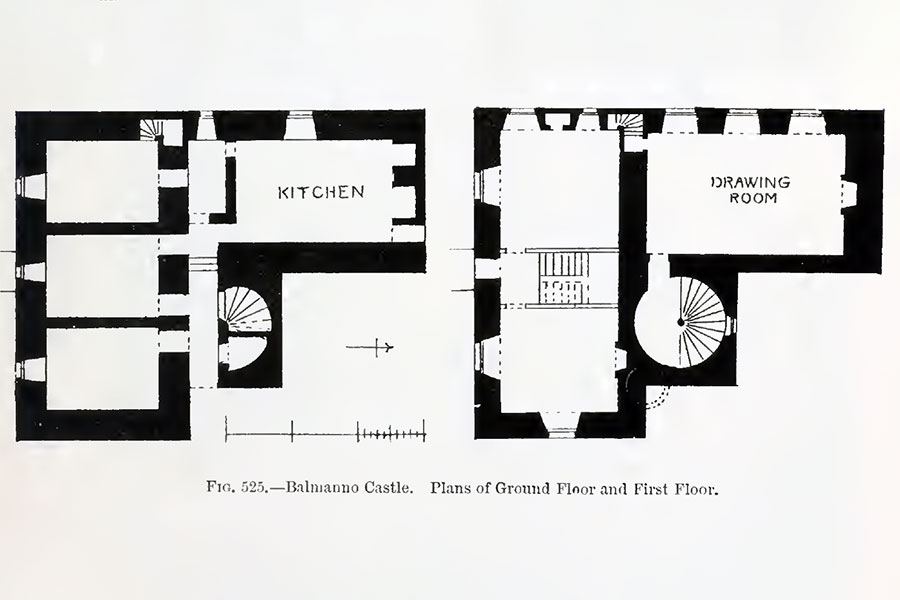
From the second floor a spiral staircase leads up to the third floor within a turret in the re-entrant angle between the square tower and the south-east end of the main block. The third floor would probably have contained accommodation for servants and possibly storage. The turret stair continued up a further storey, terminating in a circular caphouse which gave access to the battlements at the top of the square tower.
George seems to have had some standing in society, no doubt helped by his brother-in-law’s position as Regent of Scotland from 1572, and in 1576 the laird of Balmanno and the laird of Whittingehame were responsible for cross-examined one Bessye Dunlop as a suspected witch in Dalkeith. George witnessed numerous charters involving the 4th Earl of Morton during his Regency in the 1570s.
In 1578 George and Elizabeth received a charter from the young James VI confirming Alexander Balmanno’s sale of the lands of Balmanno and mentioning the manor, turret and fortalice that George built and the orchards and gardens that he planted.
Regent Morton was removed from office in the same year by the Lord Chancellor, John Stewart, 4th Earl of Atholl, and Colin Campbell, 6th Earl of Argyll. The Earl of Atholl died suddenly on his way to Stirling Castle with the former Regent Morton suspected of his poisoning. In March 1580 George was arrested and tortured by Captain James Stewart, Tutor of Arran, regarding the murder of the Earl of Atholl and a plot to transport the infant King to England, however he was subsequently released.
Later that year he was shot and left for dead at the “Stinkand Style”, a close which ran from the north side of St Giles’ Cathedral between the Tolbooth and houses on the Royal Mile in Edinburgh. In December 1581 William Bickerton of Cash went on trial accused of bearing, wearing and shooting a pistol within three quarters of a mile of the King, and of shooting George Auchinleck through the body. The motive was said to be an unreconciled dispute regarding the injury of George’s younger brother, Archibald Auchinleck of Cumledge, the previous September.
Interestingly the following January Alexander Balmanno of that Ilk went on trial under the same charges, along with Peter Balmanno, Henry Bonar of Lumquhats Mill and Archibald Bickerton, brother of the laird of Cash, perhaps suggesting some conflict between the Auchinlecks and the former owners of Balmanno.
The 4th Earl of Morton was executed in 1581 and as a result Auchinleck lost some of his influence. Later that year James VI revoked a grant to Auchinleck for the land of Stokkat at the mouth of the River Don and its fishing rights. It had been granted to him by the Earl of Morton who didn’t have the right to dispose of lands which actually belonged to the burgh of Aberdeen.
In 1582 Auchinleck was one of the Protestant nobles involved in the Raid of Ruthven when the young James VI was kidnapped by William Ruthven, 1st Earl of Gowrie, while on a visit to Ruthven Castle. He is said to have held the arm of the Earl of Gowrie so preventing him from stabbing Captain James Stewart, Earl of Arran, when the latter came to the door looking for the King.
Auchinleck was pardoned by the King in 1583 however at the end of April 1584 he was taken from Balmanno and imprisoned in Stirling Castle, seemingly accused of witchcraft and of which he was apparently cleared. In 1592 he married Jean Erskine, daughter of Alexander Erskine of Gogar and sister of Sir Thomas Erskine, 1st Earl of Kellie.
Auchinleck died in 1596 leaving two sons and two daughters. Sir George who succeeded him and married Isobel Melville, daughter of John Melville of Raith, Adam, Margaret who married Archibald Moncreiff of Balgony, minister of Abernethy and fifth son of Sir William Moncreiff of Moncreiff, and Elizabeth who married Sir Robert Douglas of Glenbervie, fourth son of William, 9th Earl of Angus.
George the younger’s first wife had died in 1593 and he married Elizabeth Wemyss soon after, although it isn’t clear which of his first two wives gave birth to his first three children, namely Sir William, Archibald and Jean, who married Sir James Lockhart of Lee in 1607. There seems to have also been another son, Alexander or Archibald.
The younger Auchinleck continued his family’s associations with the Ruthvens and in 1596 he was involved, along with James Wemyss of Bogie, John Moncreiff of Easter Moncreiff, Alexander Ruthven of Freeland, in managing the affairs of John Ruthven, 3rd Earl of Gowrie, while he spent time in Europe. However in 1597 Auchinleck pledged loyalty to the King in a document put forward by William Douglas, 10th Earl of Angus.
In 1597 Sir George married Sarah Douglas, daughter of Sir William Douglas, 9th Earl of Angus, and widow of Robert Strachan of Thornton. Alexander Balmanno of Balmanno died in 1598 and in 1600 George Auchinleck granted the two third parts of the lands of Schethin and Little Meldrum to George Seton of Auchinhuif.
The Auchinlecks seem to have climbed the social ladder once again and regained some of their former influence. In 1607 Sir George Auchinleck of Balmanno and David Murray of Balgony were Joint Commissioners for the King under the Comptroller, Sir David Murray of Arngask. Both Joint Commissioners were brothers-in-law of Archibald Moncreiff of Balgony. Auchinleck received a resignation of the remainder of Balmanno from Alexander Balmanno of Balmanno and his spouse, Eupham Arnot, in 1610 and in 1612 he was Convener of the Justices.
This rise in social status may have led Auchinleck to commission an early 17th century painted ceiling, parts of which could still be seen in the early 20th century. In 1626 he was appointed a Senator of the College of Justice as Lord Balmanno and some time between 1623 and 1629 he married Katherine Menteith, daughter of Sir William Menteith of Kerse and widow of Sir Andrew Murray of Balvaird, producing a daughter, Margaret.
Sir George was made a member of The Burgesses and Brethren of the Guild of Dundee in 1631 and his son, Alexander or Archibald, made a Burgess and Guild Brother of Dundee. Sir George retired from the Court of Session in 1638 and died soon after, being succeeded by his eldest son, Sir William.
Sir William was a Lord of Session during the reign of Charles I and married firstly Janet, daughter of Sir Robert Bruce of Clackmannan, and secondly Katherine Oliphant. Between his two wives he had eight children. His eldest son and heir, Archibald, George who in 1643 married Agnes Murray, daughter of Sir Patrick Murray of Elibank, Robert, Helen who married Thomas Erskine of Pittodrie, son of Thomas Erskine of Balhagerty, in 1643, Janet who married Sir James Balfour, 1st Baronet of Denmylne and Kinnaird, in 1654, Margaret who married John Gordon of Braco in 1650, Isabel who married Kenneth MacKenzie, brother of Sir George MacKenzie of Tarbat, and Elizabeth who married Laurence Oliphant of Pitkeathly in 1653.
Sir William sold parts of the lands of Blackness to Sir Alexander Wedderburn of Blackness in 1654, although how he came to be in possession of that property is not clear.
In 1661 William Auchinleck, described as the brother of the laird of Balmanno, was charged along with Thomas Gernilton, brother of the laird of Pottie, for wearing forbidden weapons and firing a pistol at Margaret Ainslie, wife of John Palmer, in her own home in Kirkcaldy. This would appear to be a mistake as Sir William was the laird at that time and his brother, Archibald, died in 1648. It may in fact have been Sir William’s son, also Archibald, as in 1671 he was charged, along with William Lovell of Cunachie, of the murder of William Bell, Sheriff Officer of Perth.
Sir William died in 1672 and was succeeded by Archibald. In the same year Patrick Thriepland of Fingask acquired the town and lands of Rait from “the deceased Sir William Auchinleck of Balmanno” and others.
Sir Archibald Auchinleck of Balmanno married Agnes or Anna Arnot, daughter of John Arnot of Woodmiln, and they had one daughter, Anne, who married John Carnegie of Kinnell and Braikie.
In the last quarter of the 17th century Sir Archibald sold Balmanno to a member of the Murray of Glendoick family. Some sources state that the recipient was Anthony Murray, an Edinburgh merchant and youngest son of Sir Thomas Murray of Glendoick, however Sir Thomas died at Balmanno in 1684 and his eldest son, also Sir Thomas, was described as “of Balmanno”. Sir Archibald Auchinleck was alive in 1694 but died soon after.
Sir Thomas Murray, 2nd Bt. of Glendoick and Balmanno died in 1701 and was succeeded by his brother, Sir John Hepburn Murray of Glendoick, Blackcastle and Balmanno, who in 1703 married Mary Murray, daughter of Sir Patrick Murray of Ochtertyre. Sir John died in 1714 and it may be that Balmanno passed to his younger brother, Anthony, at this time as Sir John’s son and heir succeeded as Sir Patrick Murray, 4th Bt. of Glendoick and Blackcastle, but not seemingly Balmanno.
In January 1716 during the Jacobite Rising James Drummond, 2nd Duke of Perth, advised “putting some men into the house of Balmanno” to prevent the Government troops from taking it. Later that year Sir Patrick was travelling in France where visited the exiled William Murray, Marquess of Tullibardine.
During the Jacobite Rising of 1745 James Murray, 2nd Duke of Atholl, issued an order to seize horses from local landowners who supported the Jacobites and two horses were taken from Anthony Murray of Balmanno. Anthony died without issue in 1746 and was succeeded by his nephew, Sir Patrick, who was served heir to his uncle the following year.
At some point in the 18th century most of the windows of the castle were enlarged and altered to provide more light to the interior. Large beech trees were planted on the lawn around the middle of the century. In 1751 Sir Patrick married Anne Hay, daughter of Alexander Hay of Drumelzier and Whittingehame, however he died at Balmanno in 1756. He was succeeded by their infant son, Sir Alexander Hepburn Murray, 5th Bt. of Balmanno.
In 1758 Henrietta Makgill, self-styled Viscountess of Oxfuird and daughter of Robert Makgill, 2nd Viscount of Oxfuird, died at Balmanno although I haven’t been able to ascertain whether she was residing there or just visiting. Anne Hay re-married in 1762, marrying Archibald Stirling of Keir and Cadder at Balmanno.
Sir Alexander, the 5th baronet, was served heir to his great-uncle in 1768 and was an officer in the Army however he died without issue in America in 1774 and was succeeded by his sister, Mary, who seems to have inherited her brother’s estates in the same year. In 1777 she married Colonel John Hepburn Belshes of Invermay and Buttergask.
Around 1800 some alterations were carried out to the castle and the estate developed. The five first floor windows in the west façade were given arched heads and the central window on the first floor of the south façade was converted into a door which was reached by a newly-built external stair. A scale and platt staircase was inserted between the two rooms of the first floor, leading up to the second floor. On the north side of the castle a low extension was added to provide service quarters, with access via a doorway knocked through the eastern arched recess to the right of the kitchen’s fireplace. The Castle Steading was also built around this time to the east of the castle and tree-planting took place across the estate.
This work may have been commissioned by the Colonel who in 1804 registered his arms as John Hepburn Belshes of Invermay, Balmanno and Blackcastle. He died in 1819 and was succeeded by his son, Alexander Hepburn Murray Belshes, however by 1838 Balmanno was occupied by Alexander’s brother, Major Belshes (later Major-General). Alexander was served heir to his mother in the lands of Balmanno in 1845 but died without issue in 1864 and his estates passed to his cousin, Sir John Stuart Forbes, 8th Bt. of Pitsligo and Monymusk. Sir John assumed the additional surname of Hepburn however he died two years later and was succeeded by his nephew, Sir William Forbes.
By the late 19th century the moat was still partially filled with water except for on the east side where it had been blocked with an embankment to allow carriage access. The castle was being used as a farmhouse at this time. When Sir William died in 1906 Balmanno passed to Charles Hepburn-Stuart-Forbes-Trefusis, 21st Baron Clinton, whose mother, Harriet Williamina Hepburn-Forbes, was Sir John’s only daughter. Lord Clinton commissioned Sir Robert Lorimer to draw up plans for the castle but they weren’t acted upon.

Ordnance Survey, 1901map image courtesy of NLS
In 1915 Balmanno, which was still in use as a farmhouse at that time, was bought by William S. Miller, a Glasgow shipbroker, for use as a summer residence. Lorimer was contacted once more and informed of the intention to preserve the castle’s “original characteristics as an old Scottish Baronial castle/”. Lorimer remodelled and restored the castle between 1916 and 1921 and was given considerable freedom by his client. It is considered by some to be his best work and said to be the project of his that he would have most liked to live in.
On the ground floor Lorimer converted the doorway of the east storage chamber and the southern doorway of the middle storage chamber into windows to provide borrowed light to the corridor. These two chambers were knocked through to create a large hall with plaster tunnel vault, access to which was via the northern doorway of the former middle chamber. In the west wall of this new room an ogee-arched moulded door surround was inserted giving access to the westernmost chamber which was converted into a cloakroom, with its northern end partitioned off to form a wine cellar. The former kitchen was converted into a dining room with the flanking arches knocked through to give access to the newly-built loggia and service wing’s corridor.
On the first floor Lorimer removed the scale and platt staircase from between the two rooms of the main block and converted the western two thirds into a drawing room with a smaller parlour off to the east. The former Great Hall in the wing was converted into a billiards room. The removal of the staircase allowed Lorimer to reinstate the original dimensions of the rooms on the second floor which were into bedrooms. At the south end of the north-west wing he inserted a new scale and platt staircase of late 17th century style, in addition to the existing spiral stair in the turret, that leads up to the third floor where more bedrooms are provided. The top room of the square tower was given a plaster tunnel vault and converted into a further bedroom.
The interiors were extensively renovated throughout with exquisite plasterwork in the 17th century Scottish style by Samuel Wilson and Thomas Beattie, wooden panelling by Scott Morton & Co., Nathaniel Grieve and John Watherston & Sons, other woodwork by the Clow brothers, ironwork by Thomas Hadden and stained glass by Walter and Florence Camm. Lorimer furnished the castle with a mixture of antiques and furniture designed by himself and made by Whytock and Reid. Unfortunately the 17th century painted ceiling was not retained although its restoration was apparently considered. Few interior fittings were retained which, given Lorimer’s antiquarian sensibilities and re-use of surviving fittings in other buildings, might suggest that what was left of Balmanno’s original interiors was deemed too far gone for restoration.
The eaves of the castle were lowered by just over 0.9m to steepen the roof pitch and decorative dormer-heads were added over the third floor windows. The height of the caphouse was increased by a full storey and an ogee roof with large weathervane added to it. Lorimer blocked the southernmost arched Georgian window in the west façade, presumably serving some purpose on the interior, and gave its neighbour a rectangular head. The small windows at the east and west gable ends of the main south block were blocked and the forestair on the south side of the castle was rebuilt.
To the north-east of the castle Lorimer built an extensive single storey plus attic L-plan service wing complete with crow-stepped gables and roof pitches to match the castle. This range of low buildings served to enhance the scale of the tower and connected to the early 19th century extension to the castle. Beyond this new wing Lorimer laid out a large walled kitchen garden, draining and filling in the section of the moat to the north of the castle in order to achieve this. A wide grass path bisects the garden off-centre from east to west and a two storey pavilion was built at its north-west corner.
From 1916 onwards the landscape of the estate was laid out to designs by Lorimer. The orchard and kitchen garden to the south of castle were removed and replaced by a new small walled formal garden to the east of which is a flat-roofed garage block set behind the courtyard wall. Parkland sweeps right up to the west side of the castle with the intention that “cows could be seen to graze beneath the windows”. The remaining parts of the moat were largely filled in apart from two short sections on the north and east sides.
A two storey crowstep-gabled gatehouse was built to the east of the castle approximately in line with the castle’s south wall. This gives access to a large courtyard bound by a wall between the gatehouse and castle to the south, by the castle itself to the west and by the low range of buildings and the walled garden to the north. A low wall was built immediately to the east of the castle, stretching from the service wing to the north to the courtyard wall to the south, to create a paved forecourt on the west side of the courtyard.
In 1950 Balmanno was bought by James Bruce, second son of Edward Bruce, 10th Earl of Elgin and the same year some work by Robert Hurd in 1950. From around this time the parkland to the west of the castle was developed as an informal garden, the western boundary of which is formed by the remains of the moat, while that to the south of the formal garden has been grazed by livestock. In 1958 Ian G. Lindsay & Partners were responsible for extending the service wing to the east over a flat-roofed single storey store by Lorimer.
Bruce moved to Dron House following his second marriage in 1975 and Balmanno has been let since 1982.
Alternative names for Balmanno Castle
Ballmanno; Ballmannoe; Ballmano; Ballmanow; Balmanach; Balmanauch; Balmanna; Balmannach; Balmanno House; Balmannoch; Balmannocht; Balmannow; Balmano; Balmanoch; Balmanogh; Balmanoth; Balmanov; Balmanow; Bawmanno


